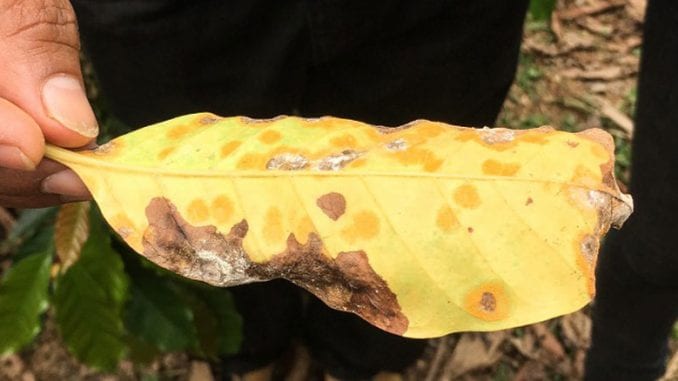
In the last edition of our series on Peru, Jackson learns about the struggles of growing coffee in Peru, and what the Pangoa cooperative does to bolster quality and fight disease.
There are coffee regions we know well, but there are regions where violence, accessibility, and poverty have detrimentally affected coffee production. In this ongoing series, we’ll highlight different coffee-producing countries and discuss the struggles producers face and how activists, baristas, and various non-profit organizations are helping to make coffee from these countries viable, more profitable, and available to a wider market.
BY JACKSON O’BRIEN
SPECIAL TO BARISTA MAGAZINE
Photos courtesy of Peace Coffee.
Peru’s coffee exports account for two percent of both the national economy and the global coffee supply. Most growers own small farms and over the last decades about 15% to 25% have joined coffee cooperatives. The Cooperativa Agraria Cafetalera Pangoa has existed in Peru’s central Amazon region, just east of the Andean mountain range, since 1977. The organization withstood the terror of the Shining Path uprising, which killed thousands of people in the 1980s and caused many farmers to flee the region. Today, Pangoa has rebounded with around 700 members. Now, however, climate change presents another challenge to the coffee cooperative and its members.
Temperature increases in Peru have reduced the cultivation areas for coffee and facilitated the spread of diseases, including coffee rust. In response, farmers in Pangoa and throughout Peru have been diversifying crops, adding cocoa or vegetables to their fields, and employing organic agricultural techniques that preserve the environment and help their coffee obtain higher prices.

I saw the intense work growers are doing to increase crop resistance and maintain their operations when I visited farms around Pangoa. We visited William Vasquez Diaz, the current board president of the co-op, and spent our time at his lower elevation plot primarily dedicated to cacao.
William talked with us about the advantages of co-op membership (higher prices, access to lines of credit and educational support) and how proud he was of his role as president. He gave us samples of raw unprocessed cacao (a marvelous and unique taste), some papayas and bananas off his farm (better than any I’ve tasted stateside) and chewable sugarcane (it tasted like sugar).

On Don Marcelo Monorato Ramos Pérez’s farm, I witnessed how to sustainably renovate a plot of land that had been ravaged by coffee rust. He had carved out his plot into terraces (basically giant steps) about 1 meter deep, allowing for easier climbing and thus easier maintenance and harvesting down the line. Planting legumes between each terrace re-nitrogenated the soil. Banana trees adjacent to the coffee trees provided shade. The plants were the children of trees on his farm that had done the best job of staving off rust. He hoped these rust-susceptible varieties such as Caturra and Bourbon would reduce the impact of the disease.
At another farm we visited, Evaristo “Floro” Jara Coronel showed us his composting and fertilizing space. Pangoa farmers fertilize their soil with bokashi, a mixture of active microbial agents that live in a vat. (It looked and smelled a bit like a kombucha mother.) Farmers feed the bokashi with sugarcane waste. The bacterial solution is then mixed with coffee cascara, cuy (or guinea pig) manure, and various other waste products and allowed to briefly ferment; creating a kind of sludge that keeps the ground around the coffee trees fertilized. Bokashi is so critical to coffee production that the co-op also has a central bokashi lab where they experiment with recipes.

I also saw a model farm the co-op had purchased to demonstrate the best agronomic practices. The plan is to plant some 9,000 coffee trees on two hectares of land at 1350 meters high. The plants had been selected and were on an on-site nursery, ready to be planted at the end of this year once the land was clear. By harvest time in 2019, if the trees are at full productivity, the co-op should have a “model farm” lot of approximately 55 bags, hopefully at a higher than average quality level using fully organic and biodynamic farming practices.

The future of Peru’s coffee production lies in the next generation of farmers using the latest organic farming techniques. The Pangoa co-op is advancing its farmers with the centralized bokashi composting plant and model farm. Members participate in hands-on workshops sponsored by Cooperative Coffees that showcase the best practices in organic agriculture.
At the latest workshop, the group experimented with recipes for manure-based fertilizers, and learned about the influences of the moon cycles on planting, transplanting, pruning and harvesting. It turns out that gravitational influences push plant liquids to the roots, which is an ideal time to prune coffee, whereas when the gravitational influences pull plant liquids to the leaves, it’s an ideal time to harvest fruit bearing trees for market.

I learned a lot in Pangoa and only scratched the surface of the challenges and complexities of coffee farming. My trip expanded my understanding of the material I work with daily as a barista by connecting me to the land and people who grow it. It deepened my appreciation of the difficult work our farmers do at origin to produce their coffee. At Peace Coffee we consider ourselves “stewards of the beans,” and by visiting Pangoa, I am even more invested in bringing out the very best in our coffee.
 ABOUT THE AUTHOR
ABOUT THE AUTHOR
Jackson O’Brien has worked in the coffee business his whole adult life. He is the Head Barista at Peace Coffee in Minneapolis. When he’s not making drinks, Jackson can be found drinking beer, cooking, finding new and interesting foods to eat, listening to socially irresponsible metal and/or rap music, finding the newest cat videos on the internet, going on adventures with his wife, playing music with friends or family, or playing croquet.

